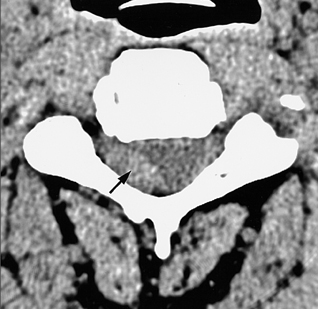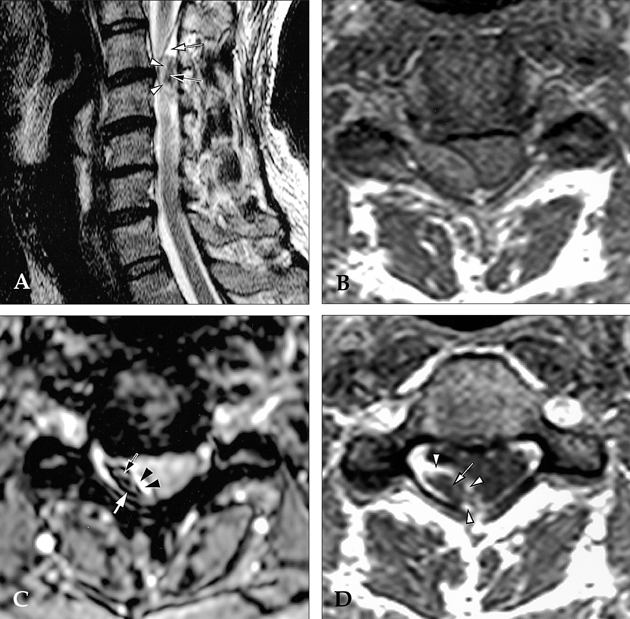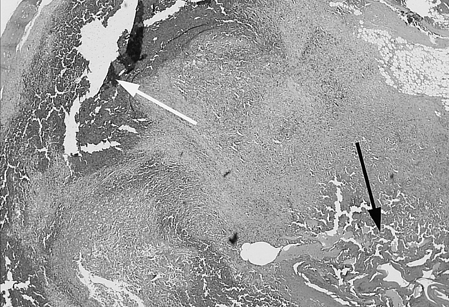Yonsei Med J.
2006 Dec;47(6):877-880. 10.3349/ymj.2006.47.6.877.
Pure Epidural Cavernous Hemangioma of the Cervical Spine that Presented with an Acute Sensory Deficit Caused by Hemorrhage
- Affiliations
-
- 1Departmet of Diagnostic Radiology, Wooridul Spine Hospital, Seoul, Korea. jbj135@hanafos.com
- 2Pochon CHA University, Bundang CHA Hospital, Sungnam-si, Korea.
- 3Yongdong Severance Hospital, Yonsei University College of Medicine, Seoul, Korea.
- 4Departmet of Neurosurgery, Wooridul Spine Hospital, Seoul, Korea.
- 5Departmet of Pathology, Wooridul Spine Hospital, Seoul, Korea.
- 6T and C Pathology Hospital, Seoul, Korea.
- KMID: 1777180
- DOI: http://doi.org/10.3349/ymj.2006.47.6.877
Abstract
- Pure epidural cavernous hemangioma of the spine without vertebral involvement is rare. Due to the slow growth of this lesion, the most common symptoms are chronic pain, myelopathy, and radiculopathy. In our case, the patient complained of an acute onset sensory deficit of the C4 dermatome. An MRI revealed an epidural mass with an acute hematoma. Here, we report a case of a pure epidural cavernous hemangioma that presented with acute neurologic symptoms caused by intralesional hemorrhage and an acute epidural hematoma, which were demonstrated on the patient's MRI.
MeSH Terms
-
Tomography, X-Ray Computed
Middle Aged
Male
Hyperesthesia/*diagnosis/etiology
Humans
Hematoma, Epidural, Spinal/complications/*diagnosis/radiography
Hemangioma, Cavernous, Central Nervous System/complications/*diagnosis/radiography
Epidural Space/radiography
Epidural Neoplasms/complications/*diagnosis/radiography
Cervical Vertebrae
Figure
Cited by 2 articles
-
Spinal Cord Tumors of the Thoracolumbar Junction Requiring Surgery: A Retrospective Review of Clinical Features and Surgical Outcome
Dong Ah Shin, Sang Hyun Kim, Keung Nyun Kim, Hyun Cheol Shin, Do Heum Yoon
Yonsei Med J. 2007;48(6):988-993. doi: 10.3349/ymj.2007.48.6.988.Spinal Epidural Arteriovenous Hemangioma Mimicking Lumbar Disc Herniation
Kyung Hyun Kim, Sang Woo Song, Soo Eon Lee, Sang Hyung Lee
J Korean Neurosurg Soc. 2012;52(4):407-409. doi: 10.3340/jkns.2012.52.4.407.
Reference
-
1. Graziani N, Bouillot P, Figarella-Branger D, Dufour H, Peragut JC, Grisoli F. Cavernous angiomas and arteriovenous malformations of the spinal epidural space: report of 11 cases. Neurosurgery. 1994. 35:856–864.2. Tekkok IH, Akpinar G, Gungen Y. Extradural lumbosacral cavernous hemangioma. Eur Spine J. 2004. 13:469–473.3. Rovira A, Rovira A, Capellades J, Zauner M, Bella R, Rovira M. Lumbar extradural hemangioms: reports of three cases. AJNR Am J Neuroradiol. 1999. 20:27–31.4. Goyal A, Singh AK, Gupta V, Tatke M. Spinal epidural cavernous hemangioma: a case report and review of literature. Spinal Cord. 2002. 40:200–202.5. Talacchi A, Spinnato S, Alessandrini F, Iuzzolino P, Bricolo A. Radiologic and surgical aspects of pure spinal epidural cavernous angiomas. Report on 5 cases and review of the literature. Surg Neurol. 1999. 52:198–203.6. Shin JH, Lee HK, Rhim SC, Park SH, Choi CG, Suh DC. Spinal epidural cavernous hemangioma: MR fingings. J Comput Assist Tomogr. 2001. 25:257–261.7. Gupta S, Kumar S, Banerji D, Pandey R, Gujral R. Magnetic resonance imaging features of an epidural spinal haemangioma. Australas Radiol. 1996. 40:342–344.8. Carlier R, Engerand S, Lamer S, Vallee C, Bussel B, Polivka M. Foraminal epidural extra osseous cavernous hemangioma of the cervical spine: a case report. Spine. 2000. 25:629–631.9. Zevgaridis D, Buttner A, Weis S, Hamburger C, Reulen HJ. Spinal epidural cavernous hemangiomas. Report of three cases and review of the literature. J Neurosurg. 1998. 88:903–908.10. Groen RJ, Ponssen H. The spontaneous spinal epidural hematoma: A study of the etiology. J Neurol Sci. 1990. 98:121–138.11. Kubo Y, Nishiura I, Koyama T. Repeated transient paraparesis due to solitary spinal epidural arteriovenous malformation- a case report. No Shinkei Geka. 1984. 12:857–862.12. Graziani N, Bouillot P, Figarella-Branger D, Dufour H, Peragut JC, Grisoli F. Cavernous angiomas and arteriovenous malformations of the spinal epidural space: report of 11 cases. Neurosurgery. 1994. 35:856–863.13. Miyagi Y, Miyazono M, Kamikaseda K. Spinal epidural vascular malformation presenting in association with a spontaneously resolved acute epidural hematoma. Case report. J Neurosurg. 1998. 88:909–911.14. Hentschel SJ, Woolfenden AR, Fairholm DJ. Resolution of spontaneous spinal epidural hematoma without surgery: report of two cases. Spine. 2001. 26:E525–E527.
- Full Text Links
- Actions
-
Cited
- CITED
-
- Close
- Share
- Similar articles
-
- Two Cases of Epidural Cavernous Hemangioma in the Thoraic Spine
- Pure Spinal Epidural Cavernous Hemangioma with Intralesional Hemorrhage: A Rare Cause of Thoracic Myelopathy
- Pure Epidural Cavernous Hemangioma in Thoracic Region: A Case Report
- Spinal Epidural Cavernous Hemangioma Simulating a Disc Protrusion: A Case Report
- Pure Thoracic Spinal Epidural Cavernous Hemangioma with Spinal Cord Compression: A Case Report




